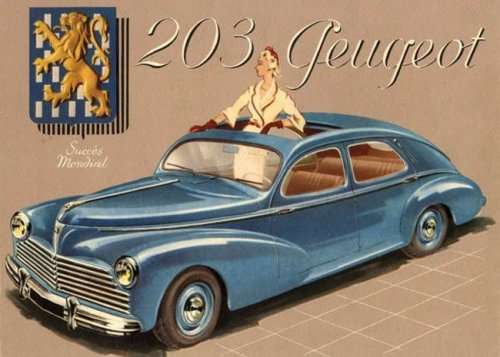Thursday 7th October 1948
At the Paris Motor Show in October, Peugeot unveiled the 203, its first totally new postwar car. The 203 has a rare feature for a standardised production car of 4 cylinders with hemispherical Alpax cylinder heads and V-inclined valve heads with spark plugs fitted in a central well. Structurally, this was the first time that Peugeot offered a monocoque shell.
The 4-door saloon was the major seller, but from 1950 a commodious 4-door version (Commerciale) and a 6-seat (Familiale), with three rows of seats, were also offered on a wheelbase lengthened by 20 cm (7.9 in) to 278 cm (109 in).[3] By taking the trouble to extend the wheelbase for the estate and family versions, the company set a pattern which they would follow with several succeeding generations of large family Peugeot estates such as the 404 and 504. In October 1952 the Paris Motor Show welcomed a modified 203 which now featured hinged quarter light windows [4] on the front ends of the front doors and an enlarged rear window on the saloon versions.[3] This upgrade also saw the removal of the speedometer from the centre of the dashboard to a position directly ahead of the driver.
Until 1953 the protruding fuel filler cap was rather exposed. (From 1953 it was recessed and protected by a flap.) Publicity shots from the early 1950s tend to avoid showing the rear of the car from the right side. That changes with 203s displayed at the 1953 Motor Show, after which the hitherto protruding fuel filler cap was sunk a couple of centimeters lower into the rear wing, and gained the protection of an opening flap set flush with the line of the bodywork.
Along with improvements to the existing cars, Peugeot introduced a 2-door 203 coupé at the end of 1952, although this was not as successful as hoped and quietly disappears from the brochures a year later. There were several low volume cabriolet and coupé conversions produced by outside specialists in collaboration with Peugeot available during the 203’s production run, though removing the roof from an early monocoque design necessitated extensive body strengthening which added to the car’s weight and reduced the performance.
For a number years the leading edge of car’s nose carried an angular, forward-leaning chrome lion bonnet ornament – the lion image being Peugeot’s trade mark. That was removed for 1959, due to safety concerns, and the logo was incorporated into a baguette shaped flatter emblem on the car’s nose.
A military variant was developed and presented to the military who showed little interest. The prototype was converted into a factory fire engine for the Peugeot plant.






